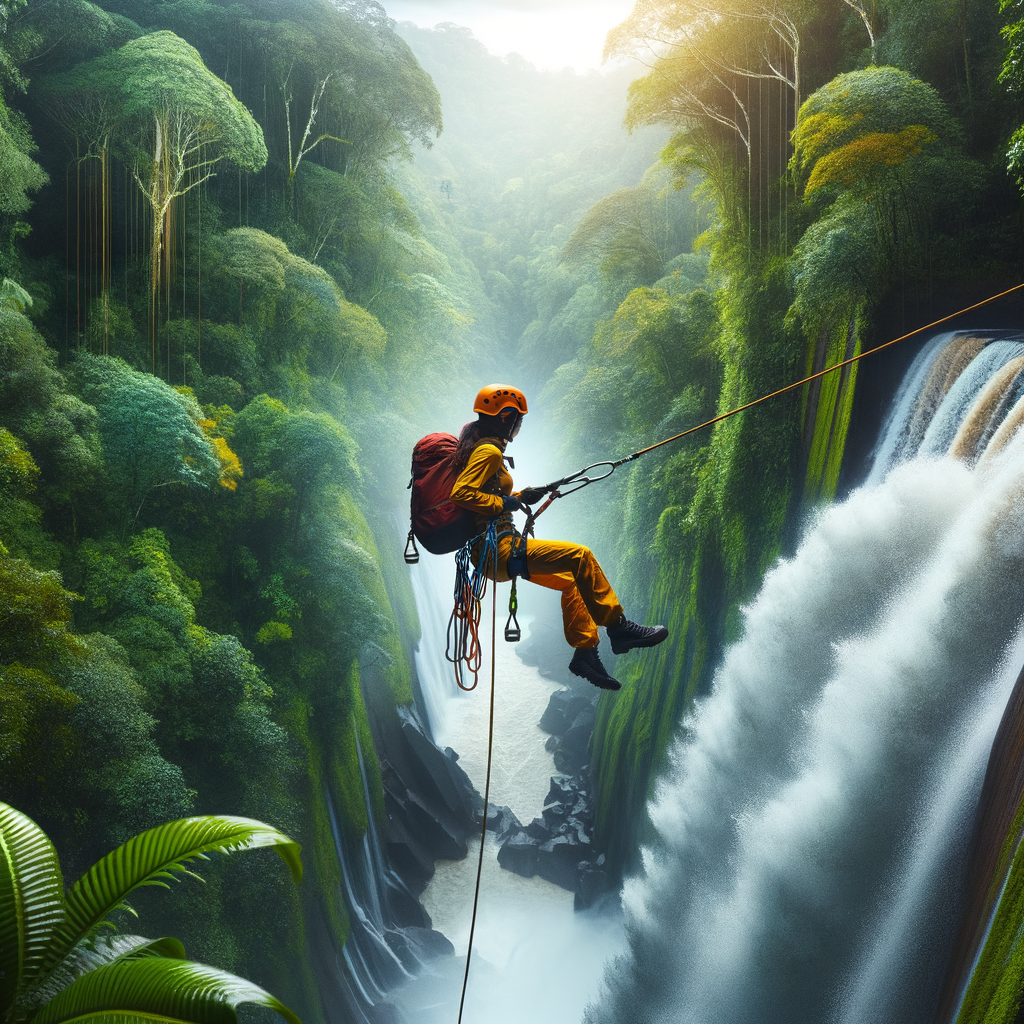
Introduction to Waterfall Rappelling
Waterfall rappelling, also known as canyoning, is an exhilarating outdoor activity that combines the thrill of adventure with the beauty of nature. This sport involves descending down a waterfall using a variety of techniques such as sliding, jumping, and rappelling. Let’s dive into the world of waterfall rappelling.
- Definition of Waterfall Rappelling
- Popularity of Waterfall Rappelling as an Extreme Sport
- The Thrill and Adventure of Waterfall Descent
Waterfall rappelling is an extreme sport that involves descending down a waterfall using a rope. Participants are equipped with a harness and a rope, which are attached to a secure point at the top of the waterfall. They then use their body weight and gravity to lower themselves down the waterfall, controlling their descent with the rope. This activity requires physical strength, agility, and a sense of adventure.
Waterfall rappelling has gained significant popularity as an extreme sport in recent years. According to a survey by the Outdoor Foundation, nearly 3 million Americans participated in rappelling in 2019. The thrill of descending a waterfall, the challenge of navigating the rocky terrain, and the opportunity to immerse oneself in nature are some of the reasons for its growing popularity.
The thrill and adventure of waterfall rappelling are unparalleled. Descending a waterfall is not just about the physical challenge; it’s also about the mental challenge. It requires courage, determination, and a willingness to step out of your comfort zone. The feeling of accomplishment when you reach the bottom of the waterfall, the rush of adrenaline as you navigate the cascading water, and the breathtaking views of nature make waterfall rappelling an unforgettable adventure.
In the following sections, we will delve deeper into the techniques of waterfall rappelling, the essential gear required, safety precautions, and some of the most beautiful waterfalls to explore. So, buckle up and get ready for an exciting journey into the world of waterfall rappelling!
Waterfall Rappelling: A Nature Obstacle Course
Waterfall rappelling is an exhilarating outdoor activity that combines the thrill of rock climbing with the beauty of cascading waterfalls. It’s like navigating through a nature-made obstacle course. But before you embark on this adventure, it’s crucial to understand the terrain.
Understanding the Terrain
Understanding the terrain is the first step in preparing for a waterfall rappelling adventure. This involves knowing the types of waterfalls suitable for rappelling, the challenges you might face, and the importance of understanding the nature obstacle course.
- Types of Natural Waterfalls Suitable for Rappelling
- Challenges in Waterfall Climbing
- Importance of Understanding the Nature Obstacle Course
Not all waterfalls are suitable for rappelling. The best ones have a steady flow of water, a clear descent path, and a safe landing area. Some popular types include plunge waterfalls, where the water drops vertically from a height, and tiered waterfalls, which have multiple drops. It’s important to research and choose the right waterfall for your skill level.
Waterfall rappelling is not without its challenges. The slippery rocks, the force of the water, and the height can all be daunting. Additionally, the terrain can change rapidly due to weather conditions, making it even more challenging. But with proper training and equipment, these challenges can be overcome.
Understanding the nature obstacle course is crucial for your safety and enjoyment. This means studying the waterfall’s structure, the flow of the water, and the surrounding area. It also involves knowing how to respond to unexpected situations, such as sudden changes in weather or water flow. The more you understand the terrain, the better prepared you’ll be for your waterfall rappelling adventure.
In conclusion, waterfall rappelling is a thrilling outdoor activity that requires a good understanding of the terrain. By knowing the types of waterfalls suitable for rappelling, the challenges you might face, and the importance of understanding the nature obstacle course, you can ensure a safe and enjoyable adventure.
Outdoor Adventure: The Rappelling Techniques
When it comes to outdoor adventures, rappelling stands out as an exhilarating activity that combines physical strength, mental resilience, and a deep connection with nature. In this section, we will delve into the world of rappelling techniques, from the basics to the more advanced, and even explore a case study from the realm of extreme sports.
-
Basic Rappelling Techniques
For beginners, understanding and mastering the basic rappelling techniques is crucial. These include:
- The Figure Eight: This is the most common rappelling technique. It involves threading the rope through a figure-eight descender, a device used for controlled descent on a rope.
- The Prusik: Named after its inventor, Dr. Karl Prusik, this technique involves using a loop of cord to secure yourself to the main rappelling rope.
- The Fireman’s Belay: This is a safety technique where a second person on the ground holds the end of the rappelling rope and can control the descent if necessary.
-
Advanced Techniques for Waterfall Rappelling
Waterfall rappelling, also known as canyoning, requires advanced techniques due to the added challenge of water. These include:
- The Cross Chest Coil: This technique helps to manage the rope in wet conditions.
- The Dülfersitz: A technique that originated in Germany, it involves wrapping the rope around your body in a specific way to control your descent.
- The Australian Rappel: Also known as face-first rappelling, this technique allows you to descend while facing downwards, which can be useful in waterfall rappelling.
-
Case Study: Successful Techniques in Extreme Sports
Extreme sports athletes often push the boundaries of what’s possible in rappelling. One such example is the Red Bull Rappelling Team, who in 2015, set a world record for the highest waterfall rappel. They used a combination of advanced techniques, including the Australian Rappel and the Cross Chest Coil, to successfully descend the 3,212-foot-tall (979 meters) Angel Falls in Venezuela.
Whether you’re a beginner or an experienced adventurer, mastering these rappelling techniques can enhance your outdoor adventures and open up a world of possibilities. Remember, safety should always be your top priority. So, always practice these techniques under the supervision of a trained professional.
Essential Rappelling Gear for Waterfall Descent
When it comes to waterfall rappelling, having the right gear is crucial. It not only ensures your safety but also enhances your overall experience. In this section, we will discuss the essential rappelling gear you need for a safe and successful waterfall descent.
Choosing the Right Gear
Choosing the right gear for waterfall rappelling can be a daunting task, especially for beginners. But don’t worry, we’re here to help. Let’s break down the gear selection process into three main areas:
- Importance of quality rappelling gear
- Recommended gear for beginners
- Advanced gear for experienced rappellers
Quality gear is the backbone of a safe rappelling experience. It not only provides the necessary support and protection but also ensures a smooth descent. High-quality gear is designed to withstand the harsh conditions of waterfall rappelling, including water exposure and potential impact. Remember, your safety is paramount, and compromising on gear quality could lead to severe consequences.
If you’re new to waterfall rappelling, start with the basics. A standard gear set for beginners should include a helmet, harness, rappel device, carabiners, and ropes. A helmet protects your head from falling debris, while a harness and rappel device control your descent. Carabiners are used to connect different parts of your gear, and ropes are your lifeline during the descent.
For those with more experience, there are advanced gear options to enhance your rappelling experience. These include specialized ropes for faster descent, advanced rappel devices for better control, and specific harnesses for added comfort. Remember, these advanced gear options should only be used if you have the necessary skills and experience.
In conclusion, choosing the right gear for waterfall rappelling is a crucial step in your adventure. Whether you’re a beginner or an experienced rappeller, always prioritize quality and safety when selecting your gear.
Safety in Rappelling: Precautions and Preparations
When it comes to waterfall rappelling, safety is paramount. It’s an exciting outdoor adventure, but it also comes with its share of risks. To ensure a safe and enjoyable experience, it’s essential to be aware of these risks and take appropriate precautions. Let’s delve into the common risks associated with waterfall rappelling, key safety measures, and the importance of emergency preparedness in extreme sports.
- Common risks in waterfall rappelling
- Key safety measures for outdoor adventure
- Emergency preparedness in extreme sports
Rappelling down a waterfall is a thrilling experience, but it’s not without its dangers. The most common risks include slipping on wet rocks, getting caught in strong water currents, and equipment failure. Additionally, sudden changes in weather can create hazardous conditions. It’s crucial to be aware of these risks and take appropriate measures to mitigate them.
When embarking on an outdoor adventure like waterfall rappelling, safety should always be your top priority. Always wear a helmet and harness, and make sure your equipment is in good working order. Never rappel alone; always have a buddy with you. Stay aware of your surroundings and the weather conditions. And most importantly, know your limits. Don’t push yourself beyond what you’re comfortable with.
In extreme sports, emergencies can happen at any time. That’s why it’s vital to be prepared. Always carry a first-aid kit and know how to use it. Have a plan in place for getting help if you need it. This could include knowing the location of the nearest hospital, having a fully charged phone with you, and letting someone know where you’re going and when you expect to be back. Remember, being prepared can make all the difference in an emergency situation.
In conclusion, safety in rappelling requires careful preparation and a keen awareness of potential risks. By taking these precautions, you can ensure that your outdoor adventure is a thrilling and safe experience.
Adventure Tourism: Exploring Natural Waterfalls
Adventure tourism is a thrilling way to explore the beauty of nature. One of the most exciting activities in this category is waterfall rappelling. This involves descending down a waterfall using a rope. It’s an exhilarating experience that combines the thrill of adventure with the awe-inspiring beauty of natural waterfalls.
Popular Waterfall Rappelling Destinations
There are numerous breathtaking waterfall rappelling destinations around the world. Let’s explore some of the top ones.
-
Top Natural Waterfalls for Rappelling Worldwide
Waterfall rappelling is a popular activity in many parts of the world. Some of the top destinations include:
- Iguazu Falls, Argentina: Known for its massive size and stunning beauty, Iguazu Falls offers a thrilling rappelling experience.
- Victoria Falls, Zambia: This is one of the largest and most spectacular waterfalls in the world, making it a popular destination for adventure tourism.
- Angel Falls, Venezuela: As the world’s highest waterfall, Angel Falls offers a unique and challenging rappelling experience.
-
Adventure Tourism Trends in Waterfall Rappelling
Adventure tourism is a growing industry, with waterfall rappelling becoming increasingly popular. This activity offers a unique way to experience nature and get a rush of adrenaline at the same time. The trend is driven by a growing interest in outdoor activities and the desire for unique travel experiences.
-
Case Study: The Economic Impact of Adventure Tourism
Adventure tourism has a significant economic impact. For example, in Costa Rica, a country known for its natural beauty and adventure tourism opportunities, the industry contributes to about 20% of the nation’s GDP. This demonstrates the potential of adventure tourism, including activities like waterfall rappelling, to boost local economies.
In conclusion, waterfall rappelling is a thrilling activity that allows you to experience the beauty of nature in a unique way. Whether you’re an experienced adventurer or a beginner, there’s a waterfall out there waiting for you to explore.
Conclusion: The Thrill of Adventure in Nature
As we wrap up our exploration of waterfall rappelling, we can’t help but marvel at the thrill and excitement that comes with this extreme sport. The journey from the top of a waterfall to the bottom is not just a physical challenge, but a mental one as well. It’s an adventure that brings us closer to nature and allows us to experience its raw beauty in a unique way.
- Personal growth and experiences from waterfall rappelling
- The future of waterfall rappelling as an extreme sport
- Final thoughts on the thrill of adventure in nature
Waterfall rappelling is more than just an adrenaline rush. It’s a journey of personal growth and self-discovery. The challenges faced and overcome during the descent can teach us valuable lessons about resilience, courage, and determination. It’s an experience that can leave us feeling stronger and more confident, ready to take on whatever life throws our way.
As more and more people discover the thrill of waterfall rappelling, the future of this extreme sport looks bright. With advancements in safety gear and training techniques, it’s becoming more accessible to a wider audience. It’s exciting to think about the new heights this sport could reach in the coming years.
There’s something truly special about adventure in nature. It’s a chance to escape from the hustle and bustle of everyday life and immerse ourselves in the beauty of the natural world. Whether it’s the rush of descending a waterfall or the peacefulness of standing at the bottom, looking up at the water cascading down, the thrill of adventure in nature is something that stays with us long after the adventure is over.
In conclusion, waterfall rappelling is an exhilarating experience that offers personal growth, adventure, and a unique way to connect with nature. As we look to the future, we can’t wait to see how this sport continues to evolve and inspire more people to step outside their comfort zones and experience the thrill of adventure in nature.













